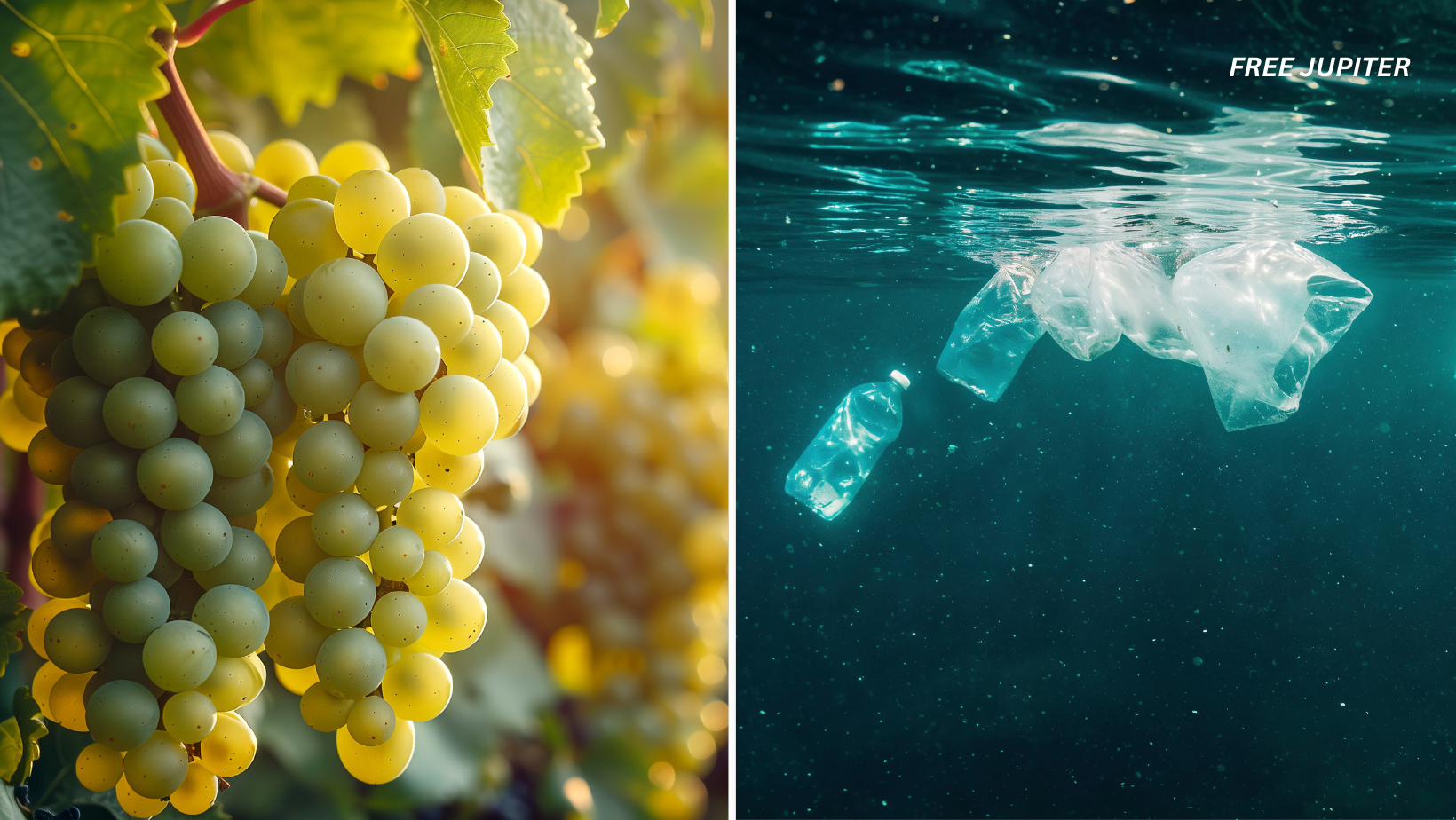Friendly Note: FreeJupiter.com shares general info for curious minds 🌟 Please fact-check all claims—and always check health matters with a professional 💙
Plastic waste has become one of the most pressing environmental challenges of our time. From oceans choked with bottles and bags to microplastics turning up in everything from seafood to drinking water, the problem feels almost impossible to escape. Traditional plastics, derived from fossil fuels, are notoriously stubborn—lingering for hundreds of years before breaking down.
But now, a surprising alternative is sprouting from the vineyards. Researchers at South Dakota State University have discovered that discarded grapevine canes—the woody, often overlooked stems pruned from vineyards every year—can be transformed into a plastic-like material that doesn’t just work well but also disappears in just 17 days. Stronger than conventional plastic yet far more eco-friendly, this discovery hints at a future where our grocery bags could biodegrade as quickly as our food scraps.
From Vineyard Waste to Biodegradable Films
Each year, vineyards prune away grapevine canes to encourage healthy fruit production. These cuttings usually pile up as waste, often ending up burned or discarded without much thought. But hidden inside these woody stems is a valuable resource: cellulose, one of the most abundant natural polymers on Earth.
Cellulose is essentially the building block of plants—it gives them structure and strength. Because grapevine canes are dense and low in moisture, they happen to be a particularly rich and convenient source of this material. The research team, led by Dr. Srinivas Janaswamy, found a way to extract the cellulose and re-form it into transparent, flexible sheets. These sheets resemble plastic film but have a crucial advantage: they naturally biodegrade in just over two weeks.
In laboratory tests, the films broke down completely within 17 days, leaving no toxic residue behind. That’s an astonishingly short lifespan compared to conventional plastics, which can persist for centuries and shed harmful microplastics along the way.
Read more: NYC Woman Finds 2.3-Carat Diamond At Arkansas State Park—Plans to Use It for Engagement Ring
Stronger Than Conventional Plastic
Biodegradable alternatives to plastic aren’t new—materials like cornstarch-based packaging and mushroom-grown foams have been making headlines for years. But what makes the grapevine version particularly promising is its strength.
According to the researchers, these cellulose-based films are actually stronger than common petroleum-based plastics. That means they’re not only eco-friendly but also practical for real-world use. Packaging, food wraps, and even shopping bags could all be made with this material without sacrificing durability.
This balance between strength and sustainability has been a sticking point in the development of plastic alternatives. Some eco-friendly options break down easily but aren’t durable enough for everyday use, while others are durable but too slow to decompose. Grapevine plastics seem to strike a rare balance between the two.
A Circular Bioeconomy in Action
The concept behind this innovation is part of what scientists call a circular bioeconomy. Instead of letting agricultural byproducts go to waste, they are repurposed into valuable resources that feed back into the economy.
In this case, vineyard waste that would otherwise be left to rot—or worse, burned and released into the atmosphere—is given a second life as a replacement for plastics. This not only reduces waste but also provides grape growers with a potential new revenue stream.
The idea is elegant in its simplicity: one industry’s leftovers become another industry’s raw material. If scaled up, such systems could dramatically reduce the amount of plastic entering landfills and oceans each year.
Why Grapevines?
Vineyards aren’t the only potential source of cellulose, but grapevines stand out for a few reasons:
- Abundant waste: Globally, vineyards produce millions of tons of canes every year after pruning.
- High cellulose density: Grapevine canes are particularly rich in cellulose, making them easier to process.
- Low moisture content: This reduces the energy needed to dry and prepare the material for extraction.
By tapping into such an abundant and underused resource, researchers aren’t just developing an eco-friendly plastic alternative—they’re also helping solve the problem of agricultural waste management.
Read more: A Brain Chip Can Now Read Human Thoughts With 74% Accuracy
The Bigger Picture: Plastic Pollution
To appreciate the significance of grapevine plastics, it’s worth considering the scale of the plastic problem. According to recent estimates, the world produces more than 400 million tons of plastic each year. About half of that is for single-use items—bags, bottles, packaging, and utensils that are discarded within minutes or hours of use.
Unfortunately, only about 9% of all plastic ever made has been recycled. The rest has either been incinerated, releasing harmful gases into the atmosphere, or left to accumulate in landfills, waterways, and oceans.
Plastic waste is so pervasive that microplastics—the tiny fragments that form as plastic breaks down—have been found in the deepest parts of the ocean, inside animals, and even in human blood and lungs. With such a massive crisis at hand, innovations like grapevine-based plastics aren’t just clever—they’re urgently needed.
Where Could This Be Used?
The most obvious application is packaging, especially in the food industry. Single-use bags, wrappers, and films are some of the worst offenders when it comes to plastic waste. A biodegradable version that vanishes in weeks rather than centuries could be transformative.
But the possibilities don’t end there. Other potential applications include:
- Agricultural films: Sheets used to cover crops could be replaced with biodegradable versions that don’t require cleanup.
- Disposable utensils and plates: Everyday convenience items could be made with grapevine cellulose instead of petroleum plastic.
- Medical packaging: Sterile wraps and disposable supplies could become more sustainable.
If this innovation scales up, it might even become a standard material for industries far beyond food.
Related Stories: Other Surprising Plastic Alternatives
The grapevine discovery is part of a broader movement to rethink how society handles packaging and waste. Around the world, researchers are exploring new and sometimes unexpected sources for biodegradable plastics:
- Seaweed and algae: Some companies are developing edible packaging made from seaweed that dissolves in water.
- Mushrooms: Mycelium, the root system of fungi, has been used to create packaging that resembles Styrofoam but breaks down naturally.
- Banana peels and cassava starch: These everyday foods have been reimagined as sources of bio-based films.
- Shrimp shells: Chitin, found in shellfish, has been tested as a sustainable alternative to petroleum plastics.
Each of these approaches has its own challenges, from scalability to durability, but together they demonstrate a growing shift toward materials that work with nature rather than against it.
Challenges Ahead
While the grapevine discovery is exciting, there are still hurdles before it becomes mainstream. Scaling up production will require investment, infrastructure, and industry buy-in. The cost of processing grapevine cellulose into films must be competitive with cheap petroleum-based plastics, which currently dominate the market.
There are also questions about how the material performs in different conditions—such as exposure to moisture, heat, or long-term storage. For grapevine plastics to replace single-use packaging, they must meet food safety standards and hold up under real-world conditions.
Still, the early results are promising, and with growing consumer demand for sustainable alternatives, momentum is on their side.
Read more: NASA’s Juno Spacecraft Could Intercept Interstellar Visitor 3I/ATLAS As It Passes Near Jupiter
A Future Shaped by Grapes
If vineyards around the world adopted this technology, the humble grapevine could help chip away at one of humanity’s most stubborn environmental problems. The fact that a product stronger than plastic can also disappear in just 17 days is a hopeful sign that science and nature can work together to create solutions.
This innovation is more than a clever recycling trick—it’s a reminder that answers to global challenges often lie in unexpected places. Grapes have long given us wine, raisins, and juice. Now, they may also give us a chance to reduce our reliance on plastics.
The next time you walk past a vineyard, those scraggly pruned canes might not look like much. But in them, scientists see the seeds of a cleaner, greener future—one where plastic waste could one day be little more than a bad memory.










